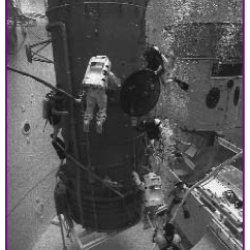Source Institutions
Source Institutions
Add to list Go to activity
Activity link broken? See if it's at the internet archive

In this activity about humans and space travel (page 1 of PDF), learners compare and contrast the behavior of a water-filled plastic bag, both outside and inside of a container of water. This activity will help learners understand the differences between environments with gravity and environments with reduced gravity. This guide includes background information, extensions, and a data sheet.
- 10 to 30 minutes
- 45 to 60 minutes
- 1 cent - $1 per group of students
- Ages 6 - 11
- Activity, Experiment/Lab Activity, Lesson/Lesson Plan
- English
Quick Guide
Materials List (per group of students)
- water
- snack-size plastic zip-top bag
- food coloring
- clear container with straight sides that holds at least 1 liter of water, or a glass aquarium in a central location
- paper towels
- copy of the "The Shape of Things" sheet
Subjects
-
Earth and Space Science
- Earth, Moon and Sun
-
Engineering and Technology
-
Engineering
- Aerospace Engineering
-
Engineering
-
Life Sciences
- Human Body
-
Mathematics
-
Data Analysis and Probability
- Data Analysis
- Data Collection
- Data Representation
-
Data Analysis and Probability
-
Physical Sciences
-
Motion and Forces
- Gravity
-
Structure and Properties of Matter
- Mass and Weight
- Volume and Density
-
Motion and Forces
-
The Nature of Science
-
The Scientific Process
- Conducting Investigations
- Gathering Data
- Formulating Explanations
- Communicating Results
-
The Scientific Process
Audience
To use this activity, learners need to:
- see
Learning styles supported:
- Involves teamwork and communication skills
- Involves hands-on or lab activities
Other
This resource is part of:
Access Rights:
- Free access
By:
- National Space Biomedical Research Institute; Chang, Kimberly ; Moreno, Nancy P. ; Tharp, Barbara Z.
Rights:
- All rights reserved, Baylor College of Medicine, 2000
Funding Source:
- NASA, NCC9-58
